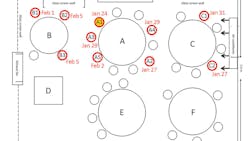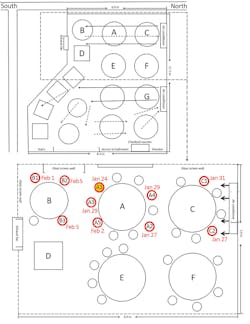Debating HVAC's Role in Spread of COVID-19 in China
Most of us in the HVAC industry have by now either read or heard about the CDC Research Letter that essentially blamed air conditioning for the COVID-19 outbreak in a Chinese restaurant.
According to the paper’s abstract:
During January 26–February 10, 2020, an outbreak of 2019 novel coronavirus disease in an air-conditioned restaurant in Guangzhou, China, involved 3 family clusters. The airflow direction was consistent with droplet transmission. To prevent the spread of the virus in restaurants, we recommend increasing the distance between tables and improving ventilation.
None of us would disagree that distance and more effective ventilation probably help to reduce the spread of many types of airborne microbial infections, including COVID-19. However, in the instant case, blaming the air conditioning for the restaurant outbreak is a conclusion to which I, and some of my learned colleagues, have taken exception.
The restaurant in question is an air-conditioned, five-story building with no operable windows, and the approximately 1,600-sq-ft, third-floor dining room is where the infections occurred. Each floor of the restaurant apparently has its own air handling unit. There is also an exhaust fan in the third-floor dining room, but from the description of the airflow patterns, it does not appear to have been operating. Prior to this incident, the tables in the dining room were approximately half of the now-recommended 6-ft distance from each other.
The authors’ reasoning behind their conclusion that the virus-laden “droplet transmission was prompted by air-conditioned ventilation” appears to be based on several premises:
- SARS-CoV-2 (the virus responsible for COVID-19 infections) is transmitted by large (>5 μm) respiratory droplets, which generally do not travel more than three feet;
- The droplets apparently traveled more than three feet;
- The AC fan was running; conclusion, the AC did it.
A second, more rigorous research paper on the same outbreak also concluded that better ventilation was needed, but it did not lay the blame on the fact that the space was air conditioned. That paper determined that the ventilation rate was only 1.6 to 2.2 cfm/person, and concluded that “the infection distribution is consistent with a spread pattern representative of exhaled virus-laden aerosols” and that “poor ventilation may explain the community spread of COVID-19”.
If the dining room had been ventilated to the requirements of IMC 2015, for example, the ventilation rate would have been 7.5 cfm/person plus 288 CFM (0.18 cfm/ft2), and the outbreak might have been avoided.
Memo to the CDC: jumping to conclusions without sound science to back them up – in this case, an obvious lack of mechanical engineering expertise on the part of the virologists – is not helpful in building public confidence.
+++++++++++++++++++
A regular contributor to HPAC Engineering and a member of its editorial advisory board, the author is a principal at Sustainable Performance Solutions LLC, a south Florida-based engineering firm focusing on energy and sustainability. Contact him at [email protected].
About the Author
Larry Clark
A member of HPAC Engineering’s Editorial Advisory Board, Lawrence (Larry) Clark, QCxP, GGP, LEED AP+, is principal of Sustainable Performance Solutions LLC, a South Florida-based engineering firm focused on energy and sustainability consulting. He has more than two dozen published articles on HVAC- and energy-related topics to his credit and frequently lectures on green-building best practices, central-energy-plant optimization, and demand-controlled ventilation.

